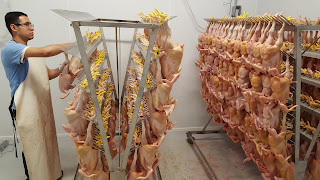"The Forest is More Than the Trees..."
by: friar Rich Rome, OFM Conv.
It
looked like a scene out of Stranger Things. We had come to the top of a mountain, which
had been the site of a strip mine in the 1990s and somewhat returned to
forest. It had been raining the entire
time we had been in Kentucky, and while it still was raining, there was a brief
reprieve in the intensity. Stepping off
the main trail, we walked through the exceptionally green brush, made so green
this year from the copious amounts of rain, until we came to the site: a circle
of burnt orange about 50 yards in diameter containing about 40 black-trunked
trees within the circle, the tallest of which were over 30 feet high. These were loblolly pines, very familiar to
me since they are one of the most common trees we have in coastal
Virginia. But here, they seemed out of
place.
The
circle of orange was the accumulation of all the pine needles they had dropped as
they had grown over the last 15 years as part of an experiment by a professor
from the University of Kentucky. While
the rest of the trees around the site had much growing underneath them, the
loblollies had very little – mostly poison ivy and other weeds. And that was the point. Loblollies, while very common in the south,
are uncommon in the mountains. While
climate change is expected to shift their growth further north, they are being
used in this experiment to keep other invasive species at bay.
In
contrast to deep mining, strip mining removes the layers of soil and rock to
get to the coal seam within a mountain.
The ecological problem this creates is that the top soil is removed and
all the layers are mixed up; it can take 150 years to naturally generate an
inch of top soil. When strip mining is
complete, companies will often plant non-native species since the native plants
cannot grow without the topsoil.
Furthermore, the soil is often compacted and rocky from the heavy
vehicle traffic, so it is very poor at retaining water. So, while the mountain may look green and
full of life, it is not a natural forest.
The
consequence of mining and climate change is worrying for the prospect of native
trees, particularly red oak and white oak (which are used to make bourbon
barrels). The loblollies seem to prevent
the non-natives from taking root and start the process of recreating top
soil. But it is very slow. One promising sign in the middle of the
orange circle: a red oak seedling was beginning to sprout. Loblollies have a short life span (for a
tree), so the hope is that native trees can move into the area once the
loblollies fall.
In
1995, the bishops of Appalachia put out a second pastoral letter, which was truly
ahead of its time. In it, they called
for sustainable forestry “since Appalachia is basically forest”; a sustainable
model could ensure that the forest’s biodiversity remains intact. “It is important to remember that the forest
is more than the trees. It is a whole
biosystem, with countless life-forms, all of which form a community of life.”[1]
[1] At
Home in the Web of Life, pages 86-87





Comments
Post a Comment